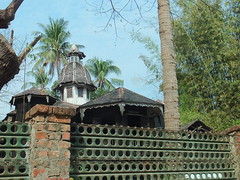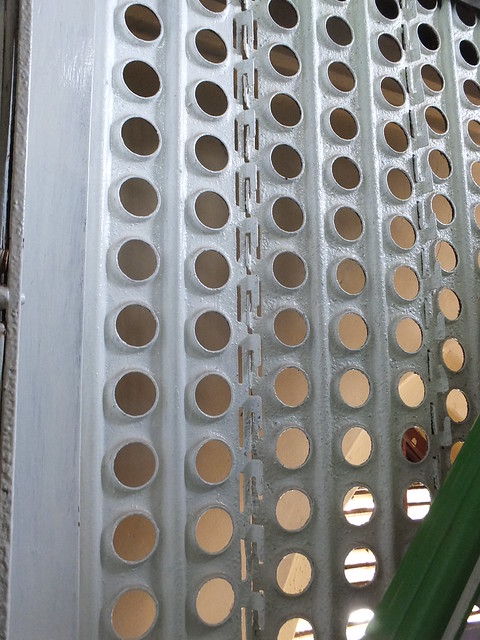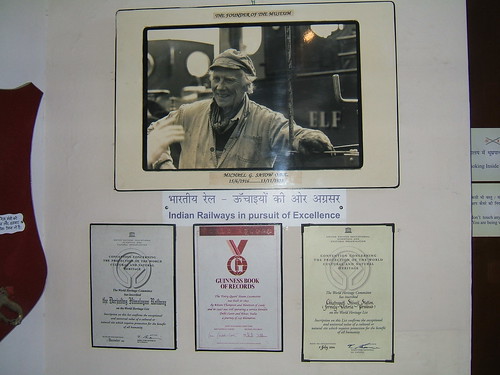skip to main |
skip to sidebar
Just before the outbreak of World War II, the United States developed a sectional steel 'mat' which could be used for the rapid construction of temporary aircraft landing strips. It was originally called 'Marsden Matting' (after the first location of manufacture) but it's also known as 'PSP', short for 'Pierced' (or 'Perforated') 'Steel Planking' or 'Landing Mat'. There's a description in Wikipedia here.
Large quantities were produced during the war and there was a later aluminium version which, of course, was a lot lighter. Whilst some of this useful material is still retained by the military, large amounts became 'Army Surplus'. Calumet Industries in the USA offered PSP when I first published this post but they seem to have disappeared. But etp-trade.de have information here (including installation instructions in English and Russian!).
I've spotted 'PSP' finding a secondary use in a number of places, particularly in the far East. The most common use is for fencing, where 'PSP' can form the horizontal rails joining brick pillars, like the example below from a private house in Yangon, Myanmar.

Yangon (2013).
The boundary fence at Thandwe Airport in Myanmar seems to be entirely made from 'PSP' horizontal rails fastened to concrete posts, as below.
 Thandwe Airport (2014).
Thandwe Airport (2014).
Perhaps the oddest use I've spotted was during a visit to Sittwe, in Myanmar. I visited a former Merchant's House (described in the section 'Merchant's House' of my post Sittwe, Myanmar) where 'PSP', enamel painted white, is used to panel-in the staircase.

Air conditioned-cladding for the staircase in the Merchant's House.
There are more pictures of the Merchant's House here.
I'm confident that there must be more outlandish uses for 'PSP' out there - I just haven't noticed them. Can anybody help?
[Dead link to Calumet Industries updated 10-Jul-2019]
This post is adapted from an article I wrote for the Summer 1989 edition of 'Lionsheart' - the newsletter of the Old Locomotive Committee (OLCO) which is the supporters group for the locomotive 'Lion'.
Locomotive building in the early days was restricted to a handful of locations. Everybody knows the importance of Tyneside, but Leeds was early into the game. ‘Lion’, of course, was built in 1838 by the partnership of Todd, Kitson and Laird in Leeds. But, shortly afterwards, the partnership was dissolved and Charles Todd joined with John Shepherd trading from the Railway Foundry in Leeds. This enterprise survived until 1858. Meanwhile, James Kitson and David Laird set up the Airedale Foundry which opened on 13th May 1839. This enterprise ultimately becoming Kitson and Company Limited and contined a proud record of locomotive building into the 1930s.
Mr. E. F. Clark, one of the founder members of OLCO, is a descendent of James Kitson and he suggested that the sesquicentenary of the opening of the Airedale Foundry should be marked by a luncheon on 13th May 1989, exactly 150 years later. Initially, the Kitson College of Technology in Leeds was chosen as the venue but, at short notice, this had to be changed to Leeds Industrial Museum at Armley Mills which made us very welcome. At the time, I was secretary of OLCO so I was involved in the organisation of the event.

The ‘flyer’ which advertised the event
(Click on image for larger view).
On the day, forty or so Guests attended the Luncheon. In 'Lionsheart' at the time I reported:-
"The weather, venue, food and, most importantly, the guests combined to produce a most happy and enjoyable occasion. Various memorabilia from the Airedale Foundry were on display. Mr. E. F. Clark appropriately described the event as 'an extended family occasion'. Later in the afternoon the Assistant Curator of the Museum, Mr. Ron Fitzgerald, gave guests a private tour of the Museum".
Some years later, in 2004, Mr. E. F. Clark donated ephemera from the Airedale Foundry Luncheon to the OLCO Archives. I remember the occasion as being very enjoyable. There was an excellent meal and plenty of good conversation (not quite all about railways). The guests were able to tour the galleries - the Museum has a wide range of displays relating to the area's industrial, mining and railway past. I particularly enjoyed a preview of a new mining gallery featuring mine locomotives which was just being readied for public exhibition.

Jan Ford and the much-missed Mike Satow (he passed away in 1993) during the lunch.
(Click on image for larger view).
Mike Satow was one of the guests at the Airedale Foundry Luncheon. He made a major contribution to the study of early locomotives and left us with a series of full-size, working replicas, such as 'Locomotion' and 'Sans Pareil'. He developed an unobtrusive emergency air brake system for the 'Locomotion' project which has been used on a number of replicas and formed the basis of the emergency braking system used on ‘Lion’ to allow her to give public rides. He was also closely-involved in the setting up of New Delhi Railway Museum. I made my first visit to this museum in 1992 (there's a brief description in my post My First Trip to India (continued) and an album of pictures here. I made another visit to the museum in February 2006 (in a hectic trip described in a long post here) which produced a second set of pictures here.
 Photograph of Mike Satow displayed in New Delhi Railway Museum.
Photograph of Mike Satow displayed in New Delhi Railway Museum.

 Thandwe Airport (2014).
Thandwe Airport (2014).




